Development of Bubble Size Correlation for Adiabatic Forced Convective Bubbly Flow in Low Pressure Condition Using CFD Code
Abstract
1. Introduction
2. Existing One Group Bubble Size Correlations
3. Two-Phase Flow Model for CFD Calculation
3.1. Turbulence Model
3.2. Two-Phase Interaction Models
4. Development of a New Bubble Size Model
5. Evaluation of Bubble Size Correlation with CFD Code
5.1. Experimental Database for the Simulation
5.2. Grid Sensitivity Test
5.3. Evaluation of the New Bubble Size Model
6. Conclusions
Author Contributions
Funding
Conflicts of Interest
References
- Wang, X.; Sun, X. Effects of Non-Uniform Inlet Boundary Conditions and Lift Force on Prediction of Phase Distribution in Upward Bubbly Flows with Fluent-IATE. Nucl. Eng. Des. 2011, 241, 2500–2507. [Google Scholar] [CrossRef]
- Ishii, M.; Kim, S.; Uhle, J. Interfacial area transport equation: Model development and benchmark experiments. Int. J. Heat Mass Transf. 2002, 45, 3111–3123. [Google Scholar] [CrossRef]
- Magnaudet, J.; Legendre, D. Some aspects of the lift force on a spherical bubble. Fascin. Fluid Dyn. A Symp. Honour Leen Van Wijng. 1998, 45, 441–461. [Google Scholar]
- Chahed, J.; Masbernat, L. Modeling Interfacial Interactions and Turbulence in the Near-Wall Region of a Vertical Bubbly Boundary Layer. J. Fluids Eng. 2020, 142. [Google Scholar] [CrossRef]
- Jin, D.; Xiong, J.; Cheng, X. Investigation on interphase force modeling for vertical and inclined upward adiabatic bubbly flow. Nucl. Eng. Des. 2019, 350, 43–57. [Google Scholar] [CrossRef]
- Lote, D.A.; Vinod, V.; Patwardhan, A.W. Computational fluid dynamics simulations of the air–water two-phase vertically upward bubbly flow in pipes. Ind. Eng. Chem. Res. 2018, 57, 10609–10627. [Google Scholar] [CrossRef]
- Kriebitzsch, S.; Rzehak, R. Baseline model for bubbly flows: Simulation of monodisperse flow in pipes of different diameters. Fluids 2016, 1, 29. [Google Scholar] [CrossRef]
- Yamoah, S.; Martínez-Cuenca, R.; Monrós, G.; Chiva, S.; Macián-Juan, R. Numerical Investigation of Models for Drag, Lift, Wall Lubrication and Turbulent Dispersion Forces for the Simulation of Gas-Liquid Two-Phase Flow. Chem. Eng. Res. Des. 2015, 98, 17–35. [Google Scholar] [CrossRef]
- Rzehak, R.; Krepper, E. Bubble-induced turbulence: Comparison of CFD models. Nucl. Eng. Des. 2013, 258, 57–65. [Google Scholar] [CrossRef]
- Frank, T.; Zwart, P.J.; Krepper, E.; Prasser, H.M.; Lucas, D. Validation of CFD models for mono-and polydisperse air–water two-phase flows in pipes. Nucl. Eng. Des. 2008, 238, 647–659. [Google Scholar] [CrossRef]
- Gemello, L.; Plais, C.; Augier, F.; Marchisio, D.L. Population balance modelling of bubble columns under the heterogeneous flow regime. Chem. Eng. J. 2019, 372, 590–604. [Google Scholar] [CrossRef]
- Marfaing, O.; Guingo, M.; Laviéville, J.; Bois, G.; Méchitoua, N.; Mérigoux, N.; Mimouni, S. An Analytical Relation for the Void Fraction Distribution in a Fully Developed Bubbly Flow in a Vertical Pipe. Chem. Eng. Sci. 2016, 152, 579–585. [Google Scholar] [CrossRef]
- Wu, Q.; Kim, S.; Ishii, M.; Beus, S.G. One-group interfacial area transport in vertical bubbly flow. Int. J. Heat Mass Transf. 1998, 41, 1103–1112. [Google Scholar] [CrossRef]
- Hibiki, T.; Ishii, M. Interfacial area transport equations for gas-liquid flow. J. Comput. Multiph. Flows 2009, 1, 1–22. [Google Scholar] [CrossRef][Green Version]
- Yao, W.; Morel, C. Volumetric interfacial area prediction in upward bubbly two-phase flow. Int. J. Heat Mass Transf. 2004, 47, 307–328. [Google Scholar] [CrossRef]
- Yeoh, G.H.; Tu, J.Y. A unified model considering force balances for departing vapour bubbles and population balance in subcooled boiling flow. Nucl. Eng. Des. 2005, 235, 1251–1265. [Google Scholar] [CrossRef]
- Lo, S.; Zhang, D. Modelling of break-up and coalescence in bubbly two-phase flows. J. Comput. Multiph. Flows 2009, 1, 23–38. [Google Scholar] [CrossRef]
- Yun, B.J.; Splawski, A.; Lo, S.; Song, C.H. Prediction of a subcooled boiling flow with advanced two-phase flow models. Nucl. Eng. Des. 2012, 253, 351–359. [Google Scholar] [CrossRef]
- Duan, X.Y.; Cheung, S.C.P.; Yeoh, G.H.; Tu, J.Y.; Krepper, E.; Lucas, D. Gas–liquid flows in medium and large vertical pipes. Chem. Eng. Sci. 2011, 66, 872–883. [Google Scholar] [CrossRef]
- Akita, K.; Yoshida, F. Bubble size, interfacial area, and liquid-phase mass transfer coefficient in bubble columns. Ind. Eng. Chem. Process Des. Dev. 1974, 13, 84–91. [Google Scholar] [CrossRef]
- Kocamustafaogullari, G.; Huang, W.D.; Razi, J. Measurement and modeling of average void fraction, bubble size and interfacial area. Nucl. Eng. Des. 1994, 148, 437–453. [Google Scholar] [CrossRef]
- Hibiki, T.; Ishii, M. Interfacial area concentration in steady fully-developed bubbly flow. Int. J. Heat Mass Transf. 2001, 44, 3443–3461. [Google Scholar] [CrossRef]
- Hibiki, T.; Ishii, M. Interfacial area concentration of bubbly flow systems. Chem. Eng. Sci. 2002, 57, 3967–3977. [Google Scholar] [CrossRef]
- Ozar, B.; Dixit, A.; Chen, S.W.; Hibiki, T.; Ishii, M. Interfacial area concentration in gas–liquid bubbly to churn-turbulent flow regime. Int. J. Heat Fluid Flow 2012, 38, 168–179. [Google Scholar] [CrossRef]
- Shen, X.; Hibiki, T. Interfacial area concentration in gas–liquid bubbly to churn flow regimes in large diameter pipes. Int. J. Heat Fluid Flow 2015, 54, 107–118. [Google Scholar] [CrossRef]
- Schlegel, J.P.; Hibiki, T. A correlation for interfacial area concentration in high void fraction flows in large diameter channels. Chem. Eng. Sci. 2015, 131, 172–186. [Google Scholar] [CrossRef]
- Fu, X.Y.; Ishii, M. Two-group interfacial area transport in vertical air–water flow: I. Mechanistic model. Nucl. Eng. Des. 2003, 219, 143–168. [Google Scholar] [CrossRef]
- Hinze, J.O. Fundamentals of the hydrodynamic mechanism of splitting in dispersion processes. Aiche J. 1955, 1, 289–295. [Google Scholar] [CrossRef]
- Jones, W.P.; Launder, B.E. The Prediction of Laminarization with a Two-Equation Model of Turbulence. Int. J. Heat Mass Tranf. 1972, 15, 301–314. [Google Scholar] [CrossRef]
- Launder, B.E.; Sharma, B.I. Application of the Energy Dissipation Model of Turbulence to the Calculation of Flow Near a Spinning Disc. Lett. Heat Mass Transf. 1974, 1, 131–138. [Google Scholar] [CrossRef]
- Siemens. Star-CCM+ User Guide. 13.06.012; Siemens: Munich, Germany, 2016. [Google Scholar]
- Tomiyama, A.; Kataoka, I.; Zun, I.; Sakaguchi, T. Drag coefficients of single bubbles under normal and micro gravity conditions. JSME Int. J. Ser. B Fluids Therm. Eng. 1998, 41, 472–479. [Google Scholar] [CrossRef]
- Auton, T.R.; Hunt, J.C.R.; Prud’Homme, M. The force exerted on a body in inviscid unsteady non-uniform rotational flow. J. Fluid Mech. 1988, 197, 241–257. [Google Scholar] [CrossRef]
- Lahey Jr, R.T.; De Bertodano, M.L.; Jones, O.C., Jr. Phase distribution in complex geometry conduits. Nucl. Eng. Des. 1993, 141, 177–201. [Google Scholar] [CrossRef]
- Troshko, A.A.; Hassan, Y.A. A two-equation turbulence model of turbulent bubbly flows. Int. J. Multiph. Flow 2001, 27, 1965–2000. [Google Scholar] [CrossRef]
- Antal, S.P.; Lahey, R.T., Jr.; Flaherty, J.E. Analysis of phase distribution in fully developed laminar bubbly two-phase flow. Int. J. Multiph. Flow 1991, 17, 635–652. [Google Scholar] [CrossRef]
- Morel, C. Turbulence Modeling and First Numerical Simulations in Turbulent Two-Phase Flows; Technical Report; CEA: Grenoble, France, 1997. [Google Scholar]
- Politano, M.; Carrica, P.; Converti, J. A model for turbulent polydisperse two-phase flow in vertical channels. Int. J. Multiph. Flow 2003, 29, 1153. [Google Scholar] [CrossRef]
- Sato, Y.; Sadatomi, M.; Sekoguchi, K. Momentum and heat transfer in two-phase bubble flow—I. Theory. Int. J. Multiph. Flow 1981, 7, 167–177. [Google Scholar] [CrossRef]
- Lopez de Bertodano, M.; Lahey, R.T., Jr.; Jones, O.C. Development of a k-ε model for bubbly two-phase flow. J. Fluid Eng. 1994, 116, 128–134. [Google Scholar] [CrossRef]
- Behzadi, A.; Issa, R.I.; Rusche, H. Modelling of dispersed bubble and droplet flow at high phase fractions. Chem. Eng. Sci. 2004, 59, 759–770. [Google Scholar] [CrossRef]
- Hibiki, T.; Ishii, M. One-group interfacial area transport of bubbly flows in vertical round tubes. Int. J. Heat Mass Transf. 2000, 43, 2711–2726. [Google Scholar] [CrossRef]
- Hibiki, T.; Takamasa, T.; Ishii, M. Interfacial area transport of bubbly flow in a small diameter pipe. J. Nucl. Sci. Technol. 2001, 38, 614–620. [Google Scholar] [CrossRef]
- Michta, E. Modeling of subcooled nucleate boiling with OpenFOAM. Master’s Thesis, Division of Nuclear Reactor Technology Royal Institute of Technology, Stockholm, Sweden, February 2011. [Google Scholar]
- Hibiki, T.; Ishii, M.; Xiao, Z. Axial interfacial area transport of vertical bubbly flows. Int. J. Heat Mass Transf. 2001, 44, 1869–1888. [Google Scholar] [CrossRef]
- Kalkach-Navarro, S.; Lahey, R.T., Jr.; Drew, D.A.; Meyder, R. Interfacial area density, mean radius and number density measurements in bubbly two-phase flow. Nucl. Eng. Des. 1993, 142, 341–351. [Google Scholar] [CrossRef]
- Islam, A.A.; Bergstrom, D.J. Modelling bubble induced turbulence for gas-liquid bubbly flow in a vertical pipe. Chem. Eng. Sci. 2019, 197, 159–171. [Google Scholar] [CrossRef]
- Song, C.H. Integral Cooling Performance Tests for Nuclear Power Plants and Development of Advanced Safety Analysis Technology (Thermal-Hydraulic Experiment for Advanced Physical Model Development); KAERI/RR-3437/2011; KAERI: Seul, Korea, 2011. [Google Scholar]
- Taitel, Y.; Bornea, D.; Dukler, A.E. Modelling flow pattern transitions for steady upward gas-liquid flow in vertical tubes. AIChE J. 1980, 26, 345–354. [Google Scholar] [CrossRef]
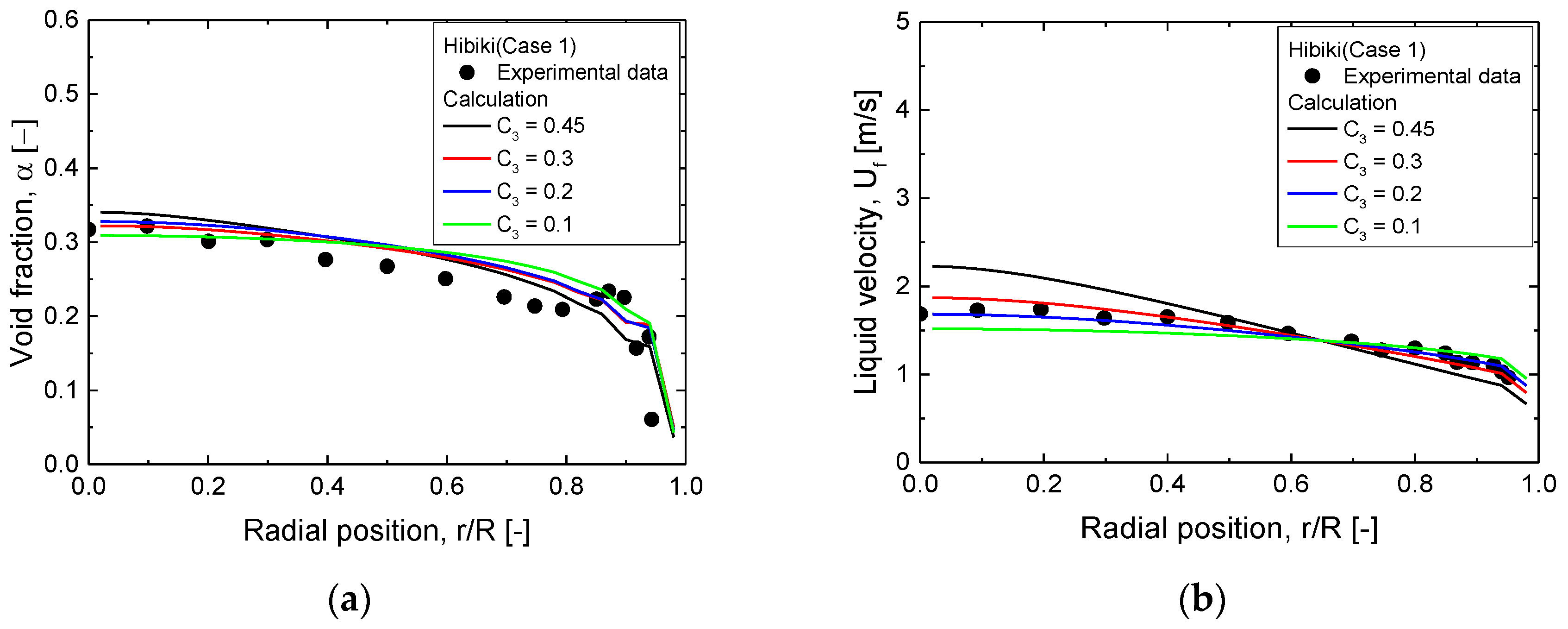
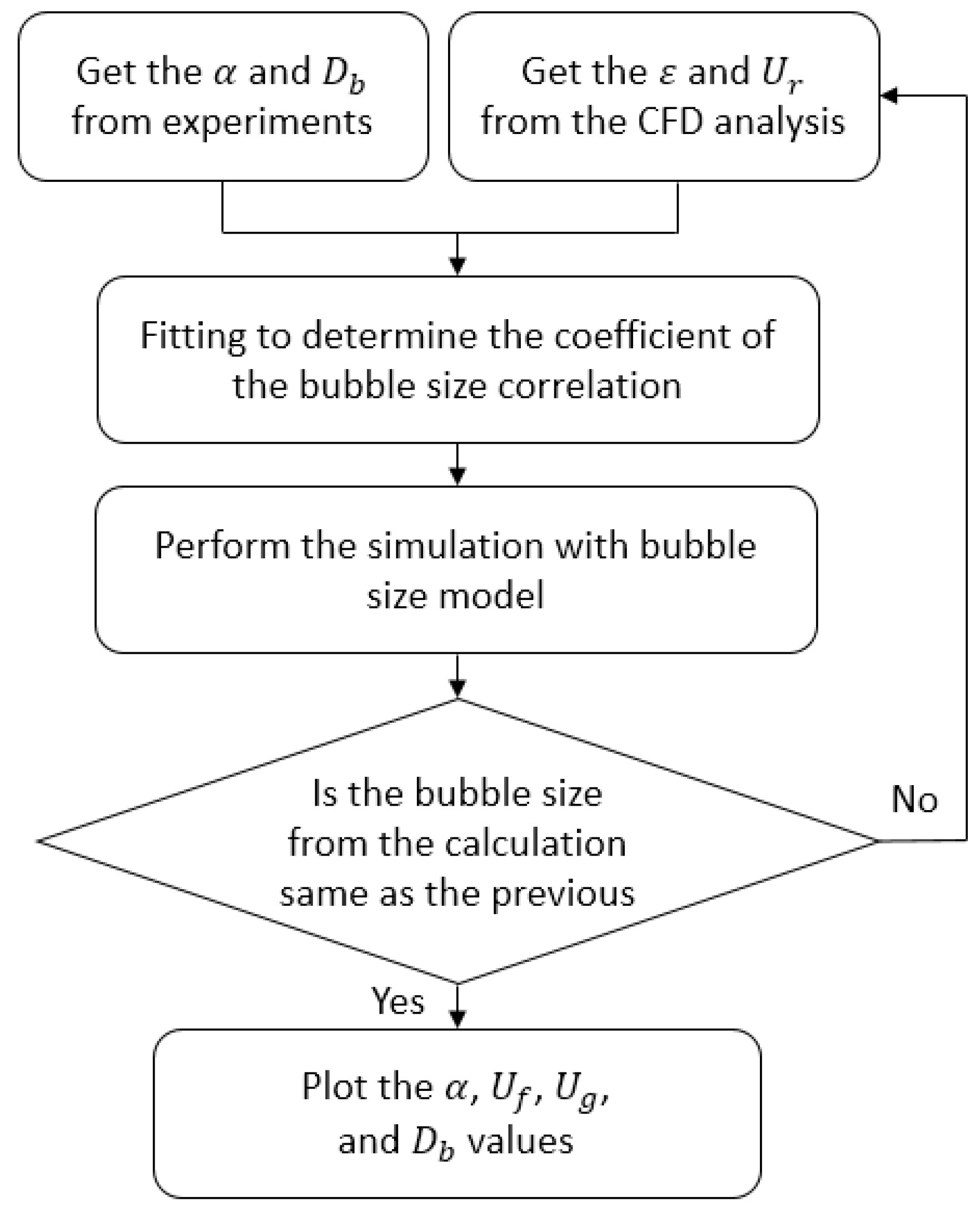
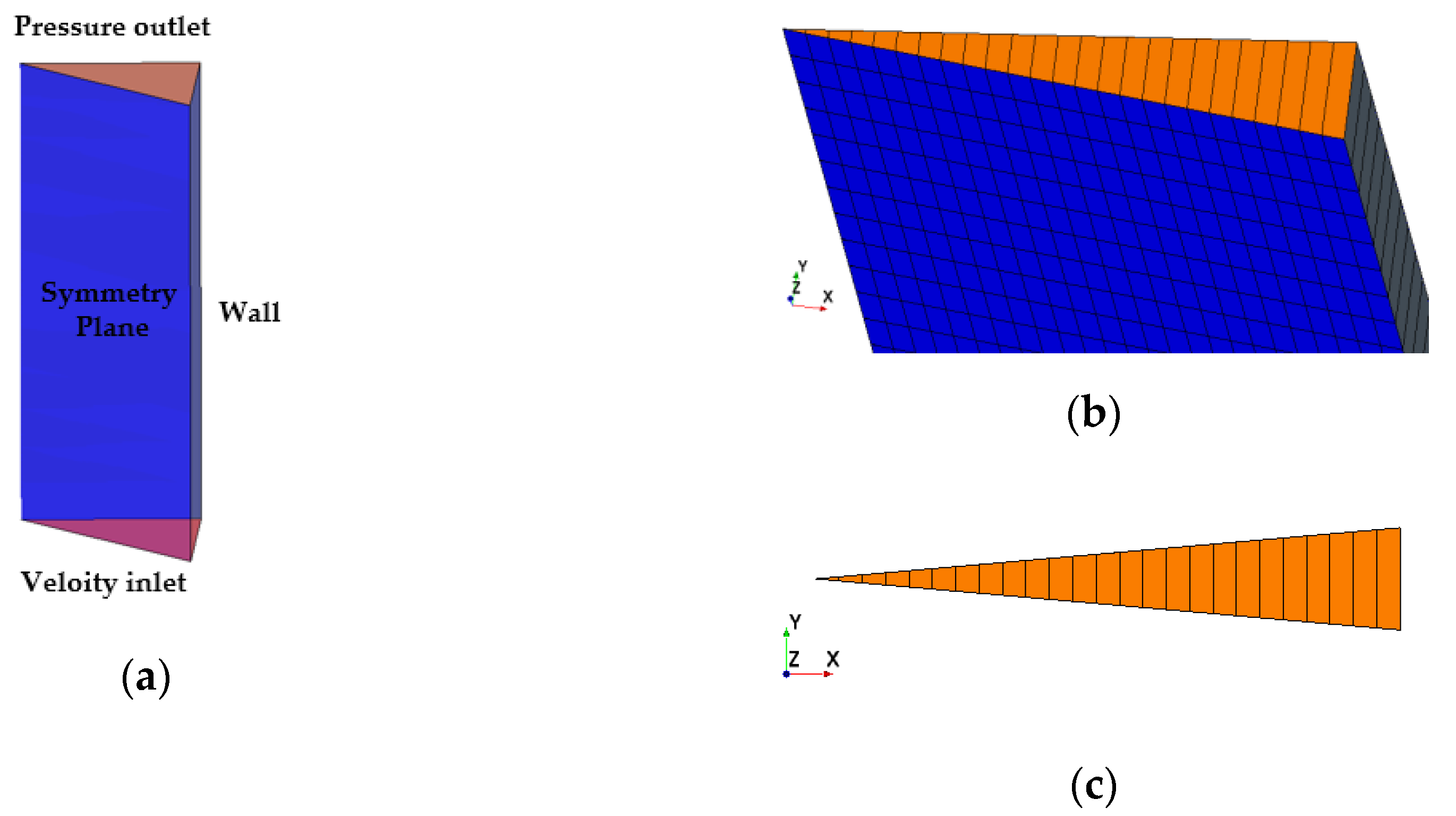

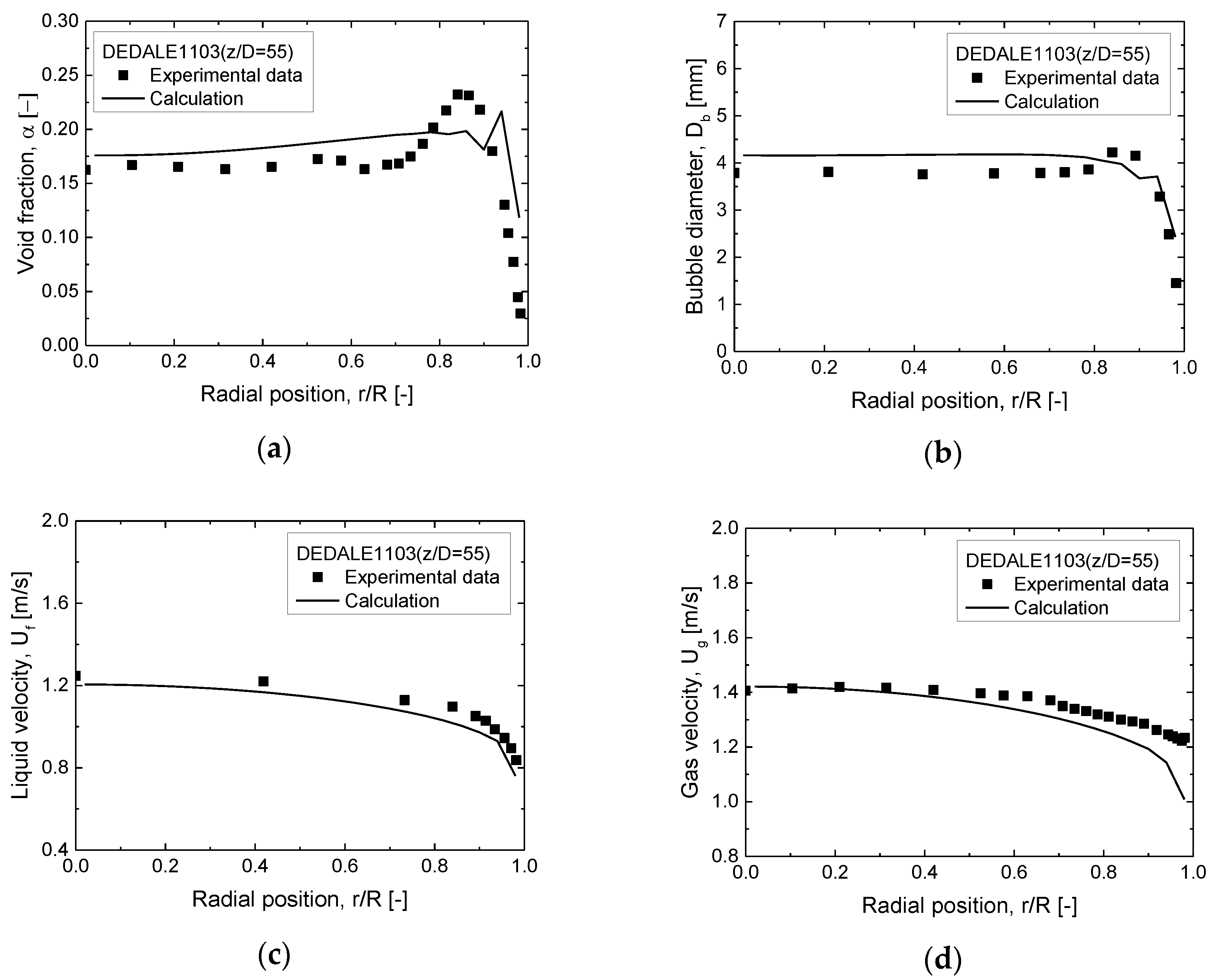
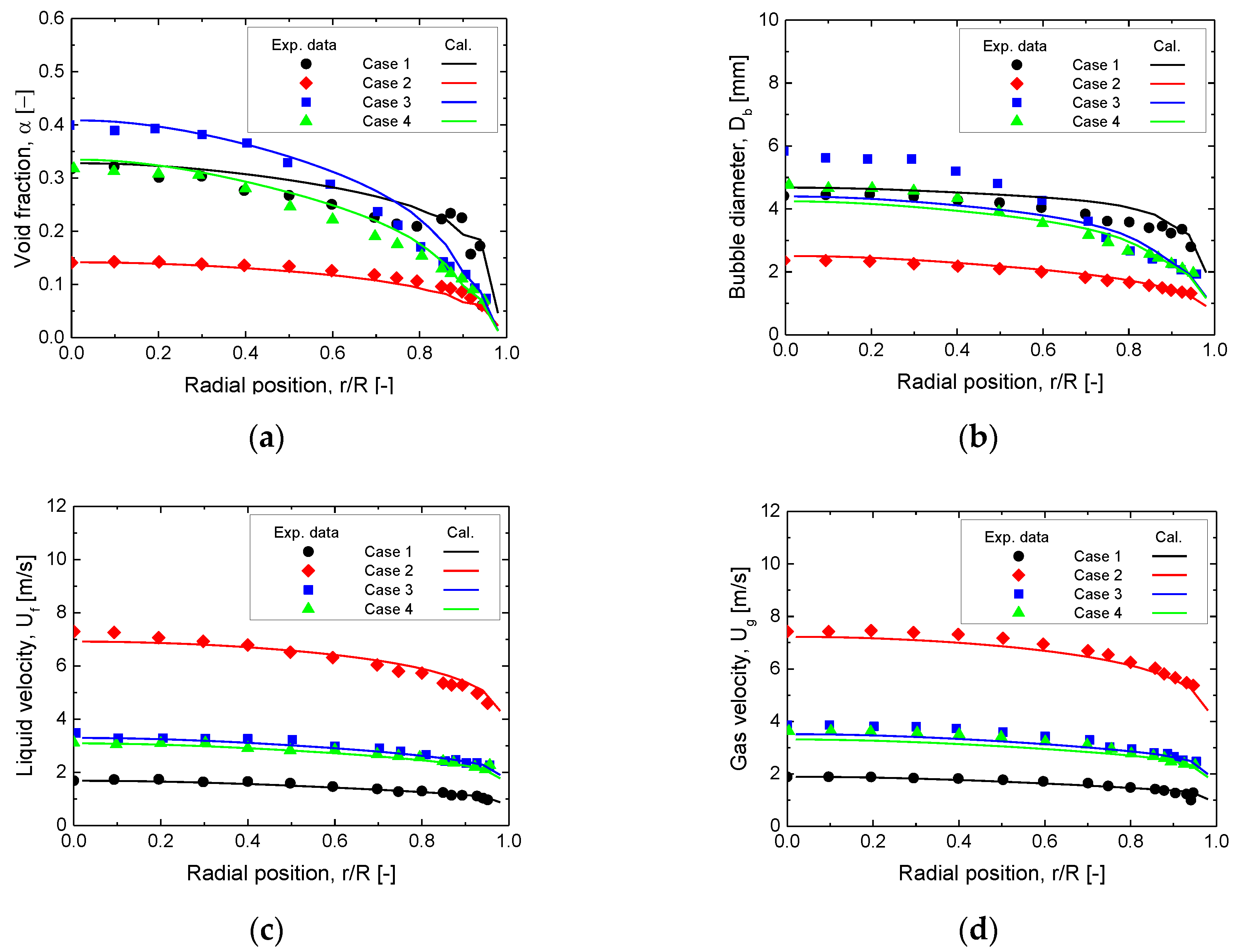
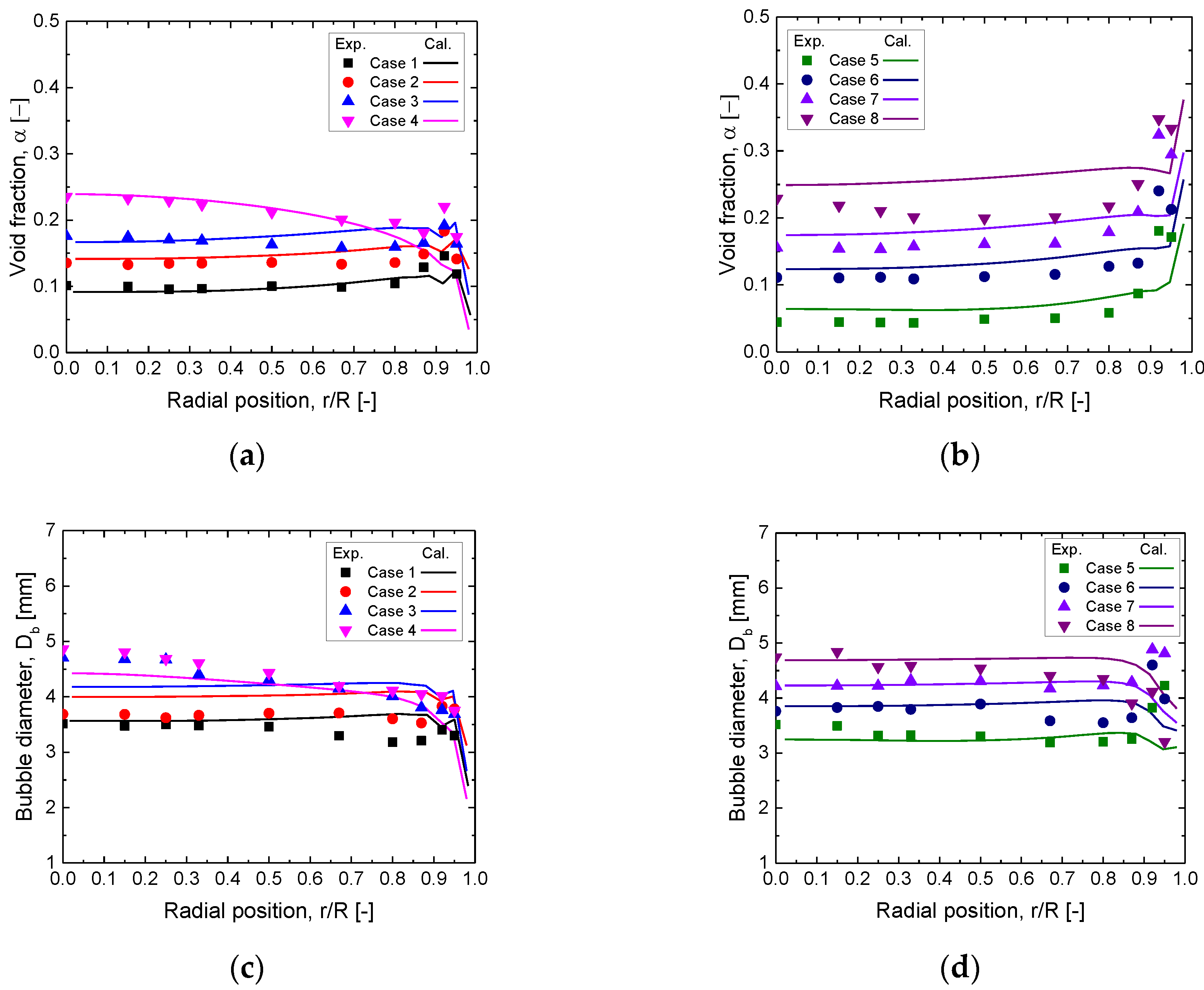
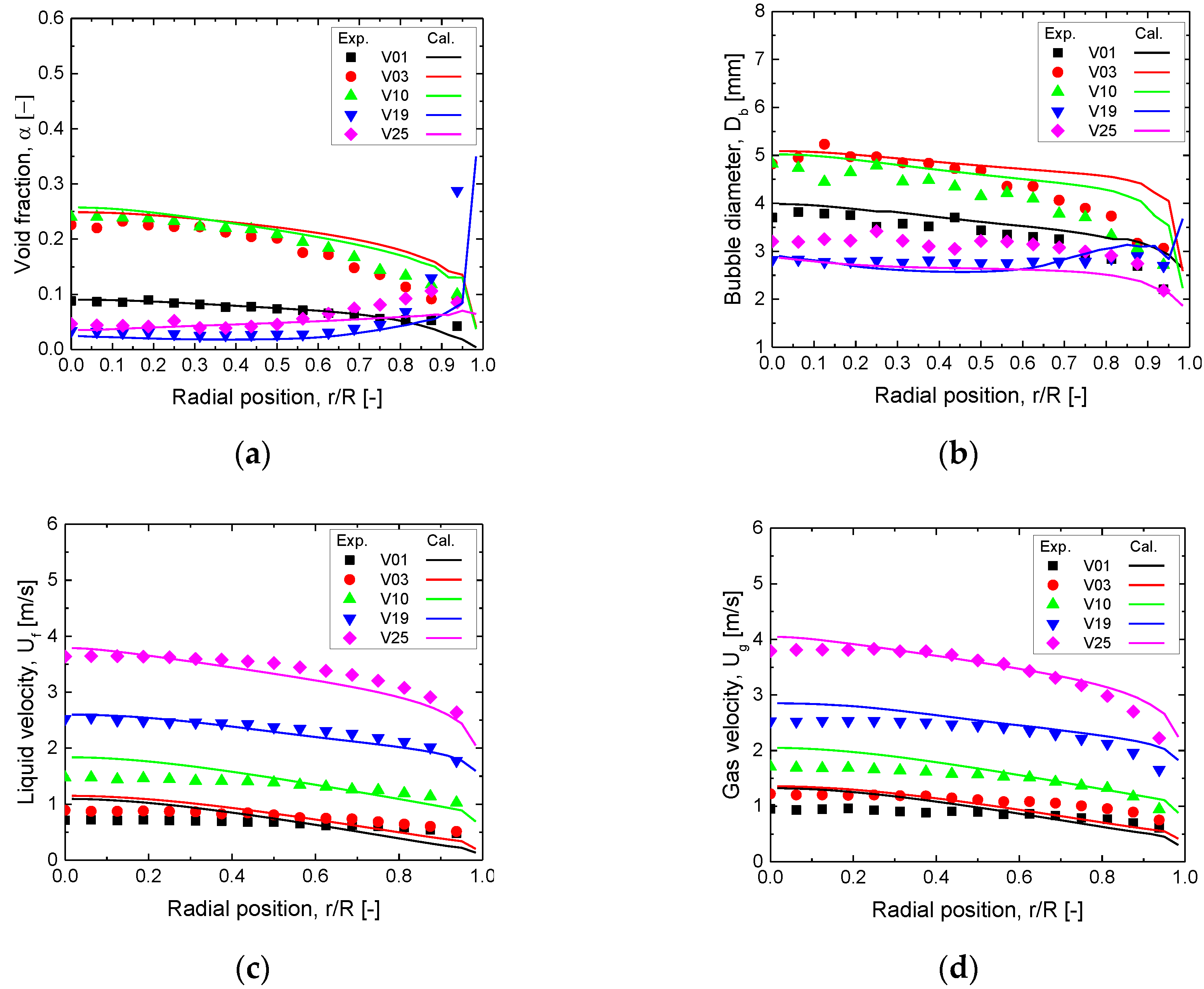
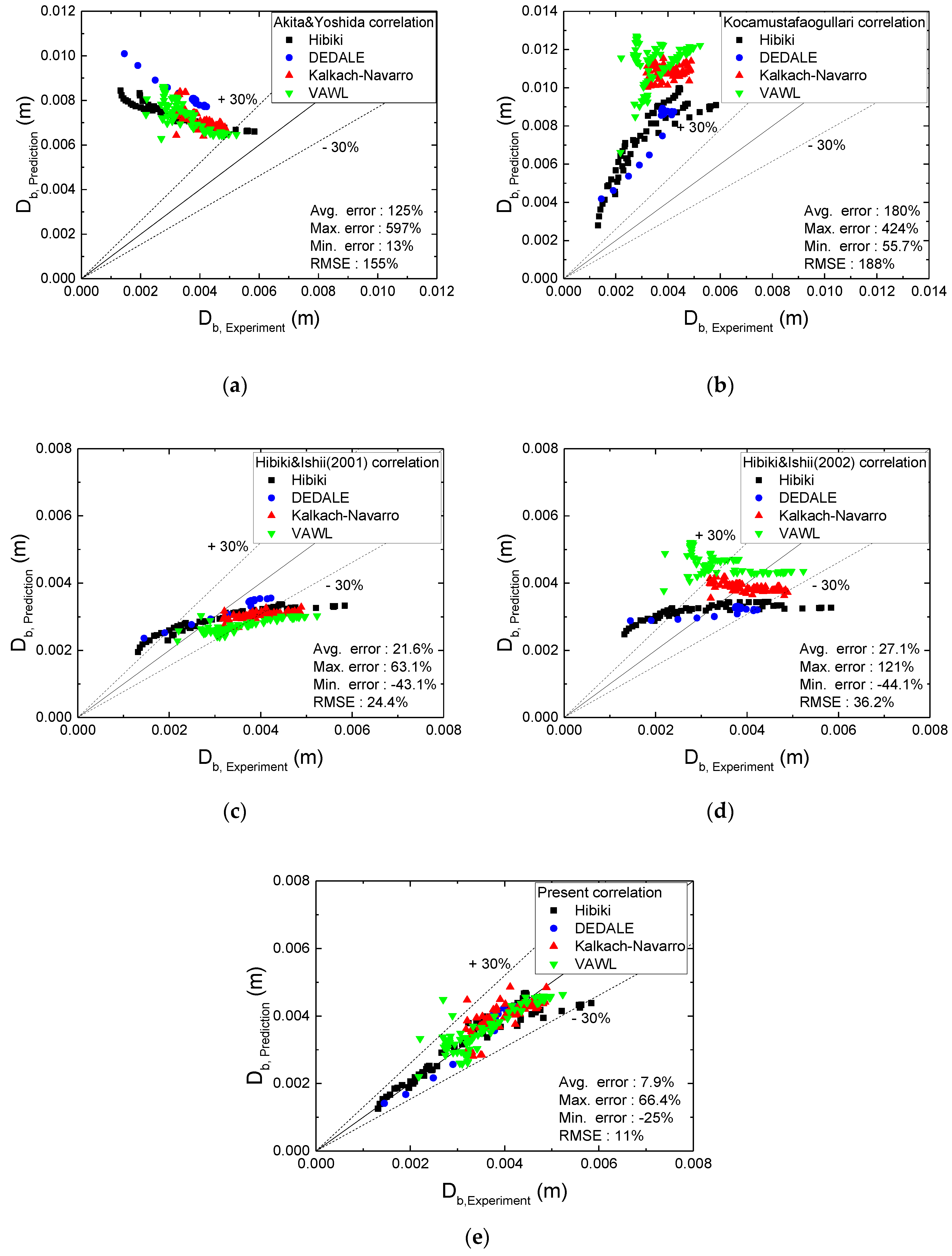
| Investigators | Bubble Size Correlation | Application Conditions | |||
|---|---|---|---|---|---|
| Flow Condition | Channel Geometry | jg (m/s) | jf (m/s) | ||
| Akita and Yoshida [20] | upward bubble columns | vertical square channel | 0.0007–0.073 | 0 | |
| Kocamustafaogullari et al. [21] | cocurrent bubbly flow | horizontal pipe | 0.21–1.34 | 3.74–6.59 | |
| Hibiki and Ishii [22] | adiabatic, diabatic bubbly flow | vertical pipe, horizontal pipe, annulus, bundle | 0.0029–4.87 | 0.261–6.55 | |
| Hibiki and Ishii [23] | adiabatic, diabatic bubbly flow, bubble columns | vertical pipe, horizontal pipe, annulus, bundle | 0.0007–4.87 | 0–6.55 | |
| Mechanism | Model | Reference |
|---|---|---|
| Turbulent impact | Hibiki and Ishii [42] | |
| Random collision | Hibiki and Ishii [42] | |
| Wake entrainment | Hibiki et al. [43] |
| Experiment | Inner Diameter (mm) | Height (m) | Measurement Location (z/D) |
|---|---|---|---|
| DEDALE [44] | 38.1 | 6 | 55 |
| Hibiki [45] | 50.8 | 3.06 | 53.5 |
| Kalkach-Navarro [46] | 60 | 3.5 | 50 |
| VAWL [48] | 80 | 10 | 42.2 |
| Experiment | Superficial Gas Velocity (m/s) | Superficial Liquid Velocity (m/s) | Void Fraction (−) | Absolute Pressure at the Outlet (Bar) | |
|---|---|---|---|---|---|
| DEDALE | 1103 | 0.1851 | 0.877 | 0.152 | 1.0 |
| Hibiki | Case 1 | 0.321 | 0.986 | 0.231 | 1.0 |
| Case 2 | 0.518 | 5 | 0.106 | ||
| Case 3 | 0.624 | 2.01 | 0.228 | ||
| Case 4 | 0.471 | 2.01 | 0.183 | ||
| Kalkach-Navarro | Case 1 | 0.081 | 0.5 | 0.109 | 3.5 |
| Case 2 | 0.114 | 0.5 | 0.142 | ||
| Case 3 | 0.135 | 0.5 | 0.169 | ||
| Case 4 | 0.148 | 0.5 | 0.211 | ||
| Case 5 | 0.1 | 1.0 | 0.077 | ||
| Case 6 | 0.191 | 1.0 | 0.138 | ||
| Case 7 | 0.27 | 1.0 | 0.195 | ||
| Case 8 | 0.4 | 1.0 | 0.241 | ||
| VAWL | V01 | 0.05 | 0.5 | 0.063 | 1.0 |
| V03 | 0.16 | 0.5 | 0.161 | 1.0 | |
| V10 | 0.27 | 1 | 0.163 | 1.0 | |
| V19 | 0.12 | 2 | 0.073 | 2.0 | |
| V25 | 0.17 | 2.85 | 0.063 | 1.0 | |
| Experiments | Radial | Axial |
|---|---|---|
| DEDALE | 25 | 1200 |
| Hibiki | 25 | 612 |
| Kalkach-Navarro | 30 | 700 |
| VAWL | 30 | 1000 |
| Bubble Size Correlation | Average Error | RMSE |
|---|---|---|
| Akita and Yoshida | 125% | 155% |
| Kocamustafaogullari | 180% | 188% |
| Hibiki and Ishii (2001) | 21.6% | 24.4% |
| Hibiki and Ishii (2002) | 27.1% | 36.2% |
| Present | 7.9% | 11% |
© 2020 by the authors. Licensee MDPI, Basel, Switzerland. This article is an open access article distributed under the terms and conditions of the Creative Commons Attribution (CC BY) license (http://creativecommons.org/licenses/by/4.0/).
Share and Cite
Bak, J.; Kim, H.; Jeong, J.J.; Euh, D.; Yun, B. Development of Bubble Size Correlation for Adiabatic Forced Convective Bubbly Flow in Low Pressure Condition Using CFD Code. Appl. Sci. 2020, 10, 5443. https://doi.org/10.3390/app10165443
Bak J, Kim H, Jeong JJ, Euh D, Yun B. Development of Bubble Size Correlation for Adiabatic Forced Convective Bubbly Flow in Low Pressure Condition Using CFD Code. Applied Sciences. 2020; 10(16):5443. https://doi.org/10.3390/app10165443
Chicago/Turabian StyleBak, Jinyeong, Huiyung Kim, Jae Jun Jeong, Dongjin Euh, and Byongjo Yun. 2020. "Development of Bubble Size Correlation for Adiabatic Forced Convective Bubbly Flow in Low Pressure Condition Using CFD Code" Applied Sciences 10, no. 16: 5443. https://doi.org/10.3390/app10165443
APA StyleBak, J., Kim, H., Jeong, J. J., Euh, D., & Yun, B. (2020). Development of Bubble Size Correlation for Adiabatic Forced Convective Bubbly Flow in Low Pressure Condition Using CFD Code. Applied Sciences, 10(16), 5443. https://doi.org/10.3390/app10165443




